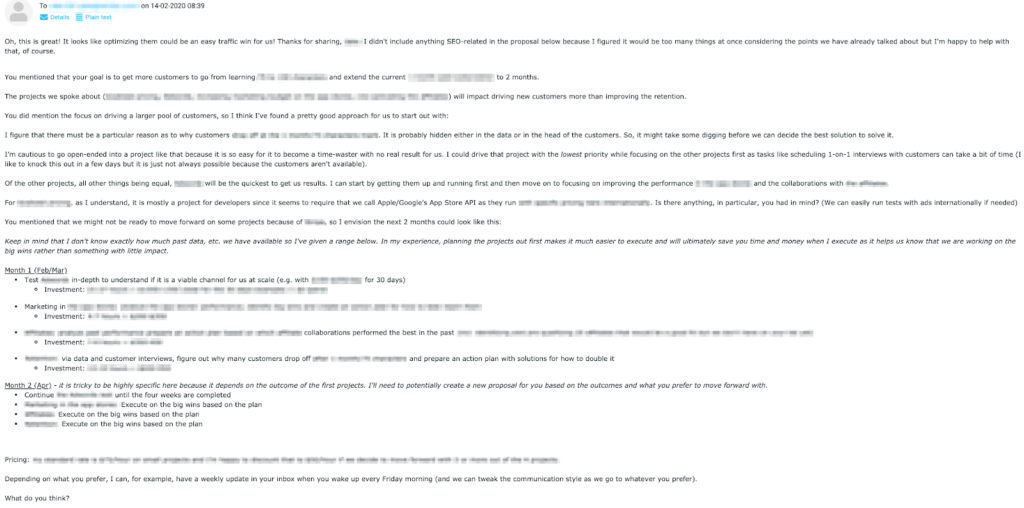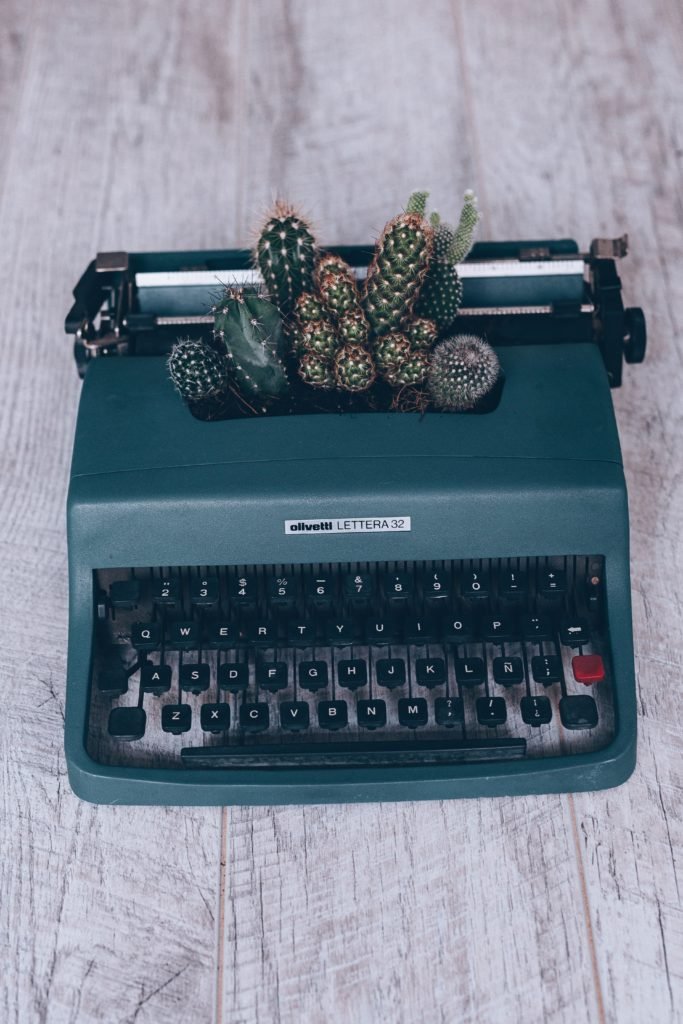Freelance proposal letters are a bit like internship applications. At one point I was stuck with a dead-end internship in Portugal. I wanted a change and so I sent out 100 cover letters to cool looking advertising agencies with the hope that I could land a better one.
My goal was to send out exactly a hundred, in part as curiosity to see what would happen and in part as I was thinking that by sending out that many, surely something would stick.
It was an epic fail and I didn’t hear back from 98 out of them but luckily one of them was a good match.
I’ve had the same experience with freelance proposals but eventually, I figured out how to make them work and I’ve since earned thousands of dollars from freelance projects.
It turns out that sending fewer and making each one better is much easier. Who would have thought!
In this article, we’ll look at samples of freelance proposal letters that won projects, why they worked and specific common mistakes to avoid.
Samples of proven freelance proposal letters that won projects
Let’s begin by looking at a few winning proposals from freelance websites like Upwork, generously shared by our readers.
From Upwork
Project description:
The cover letter:
He landed the gig at $35/hour.
Another example below. The project description:
And the proposal:
The reader won the project earning $250.
From outside freelance platforms
Outside of freelance platforms, freelance proposal letters often look like some variation of this:
Standard proposal (outside freelance platforms)

These are a bit different compared to on freelance platforms since there the proposal is the first communication with the potential client.
Outside, the proposal letter usually has no new information and is more so a recap of what you and the business have discussed. Like a conclusion of sorts after a phone call and a verbal agreement that we can work together — making the intangible, tangible.
Unfortunately, many of us mistake the proposal as the thing that will win you the project but most successful people seem to agree, that when you reach this step the important work has already been done.
Of course, this isn’t always the case. Some choose to hold back on their pricing and only reveal it in the final proposal before the client agrees or not.
I generally prefer to do it before, especially on a call or in-person if possible, because it gives me the opportunity to see the real reaction on the client’s face.
I don’t negotiate my rates but the feedback helps me better understand if I’m working with the right type of clients. Sometimes we work with clients that can barely afford us but because they love the service, they keep the agreement until at one point the bill becomes too high because they want us to complete more and more projects.
It’s difficult to know in advance but we are actually doing them a disservice by continuing to work with them. We are also doing ourselves a disservice because we are constantly at a ceiling that we can’t break through because the client’s business is too small.
Seeing their immediate reaction to the price, I get a sense of whether the ball-park is right and when I look for new clients I’ll better be able to adjust.
On freelance platforms like Upwork, it is particularly tricky because the first contact point (the first message) to clients is called “the proposal”. It is misleading since clients tend to only accept projects without any further interaction if the project is small.
The type of clients that upload projects on these platforms are often inexperienced and not that great at describing what they need, and so it becomes impossible to write them a good proposal.
Why the proposal letters worked
One of the reasons why the Upwork proposals above work is that the freelancer spends time acknowledging the lack of a relationship between the freelancer and client, yet also begins to build the relationship by sharing the background of the freelancer in a way that is relevant to the project.
That last bit is key. Most of us tend to say “I did this, I know that” whether in a cover letter for a job or in a client proposal, but forget to show the client how it relates specifically to their project.
When working remotely, it is likely that we will work with someone from a different culture. So being aware that we come with different backgrounds, showing where we come from and what we need in order to do a good job for them is essential.
The Upwork proposals above points out how the client didn’t share a particular detail that the freelancer needs to understand in order to help. And they didn’t stop there.
Instead, they go on to build a relationship with the client by showing how they have solved a similar project for another client and how they went about that.
At the heart of it, it comes down to three elements:
- Summarize the client’s problems to show that you understood them
- Show the solution and potential results
- Show why you are the person for the project e.g. you’ve done something similar
Notice that I didn’t say that we must show two case studies followed by a nice comment to hack it. Building trust with the potential client is a fluid process and once we move from focusing on the project to focusing on the person, we tend to see great results.
3 common freelance proposal letter mistakes

There are a few things that I notice many readers tend to do over and over again, that crushes their chances of winning the freelance project.
Some are more important than others and because we can only do so much, let’s focus on those that will really move the needle. Simply avoiding these three will make a big difference for you:
- Trying to save time with templates
- Ignoring the human aspect
- Thinking that the proposal can’t be revised
Trying to save time with templates
This one is often misunderstood. Because templates tend to perform badly, we have to send more proposals and thus it takes more work to land clients.
Some freelancers are mass-sending generic template proposals out. I’ve seen it mostly on freelance platforms but it happens via email as well.
The point is to make it a volume game and because of the sheer size, if just a tiny percentage are interested, it works out because it is possible to automate the sending of them with tools.
Some argue that if the potential clients are desperate enough to respond to those messages, they are able to land them. It technically works but there’s something to be said about the quality of those clients.
Interestingly, I hardly ever hear those freelancers sharing how awesome their clients are and how they are earning great money working with them.
At the same time, I never hear those clients talk about this amazing contractor they are working with… see a pattern?
When we work with smart clients, granted we have to work harder to impress them but the outcome is beyond worth it. Smart clients that love us, send us repeat work all the time and refer us to other great clients — and the circle continues.
The thing is that there is something within great clients that makes them connect with other great clients like how successful people know other successful people. There is just nothing like the trust of a mutual connection to spur a relationship between us and a new great client.
Instead of spending hours impressing them cold, from scratch, without charging them, we can go straight to the profitable billable hours where we earn money.
Ignoring the human aspect
Unfortunately, a lot of us freelancers think that freelancing is project-based when in reality it is relationship-based.
Often we have the expertise that a client needs but that isn’t always all we need in order to do good business with them. We also need to show them that they can trust us to do a good job with the resources available.
That’s why businesses often show logos like “as seen in” and “featured on”. It’s basically outsourcing the solution to somewhere else, thinking that if that person/brand likes them, they must be good enough for us as well. A trust indicator of sorts.
There may or may not be a lot of faults with thinking this way. Especially, considering how easy it is to get those logos but nonetheless, that’s how we humans function. So, that’s the game we have to play.
Thinking that the proposal can’t be revised
The final big mistake I often see is thinking that the proposal is the end all be all. It can absolutely be revised and you might even want to consider having the client be part of the process of drafting the proposal, so you are sure they are happy with the outcome. That way they are more likely to agree that if we send them a whole big document out of the blue.
It’s another opportunity to build a deeper connection with the client and since this is trust-based, another opportunity to help them trust us. This sometimes comes through the sheer exposure to us as people.


